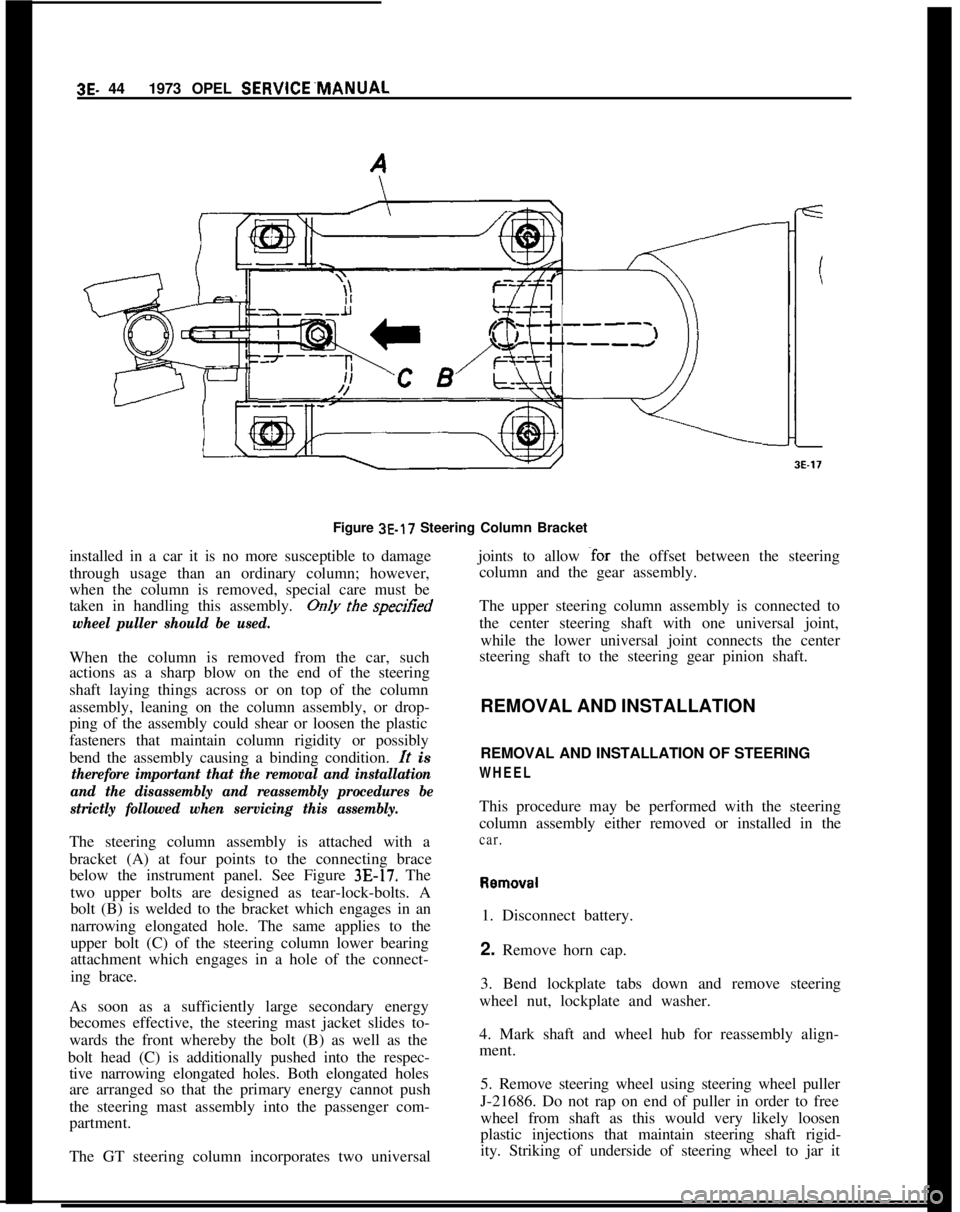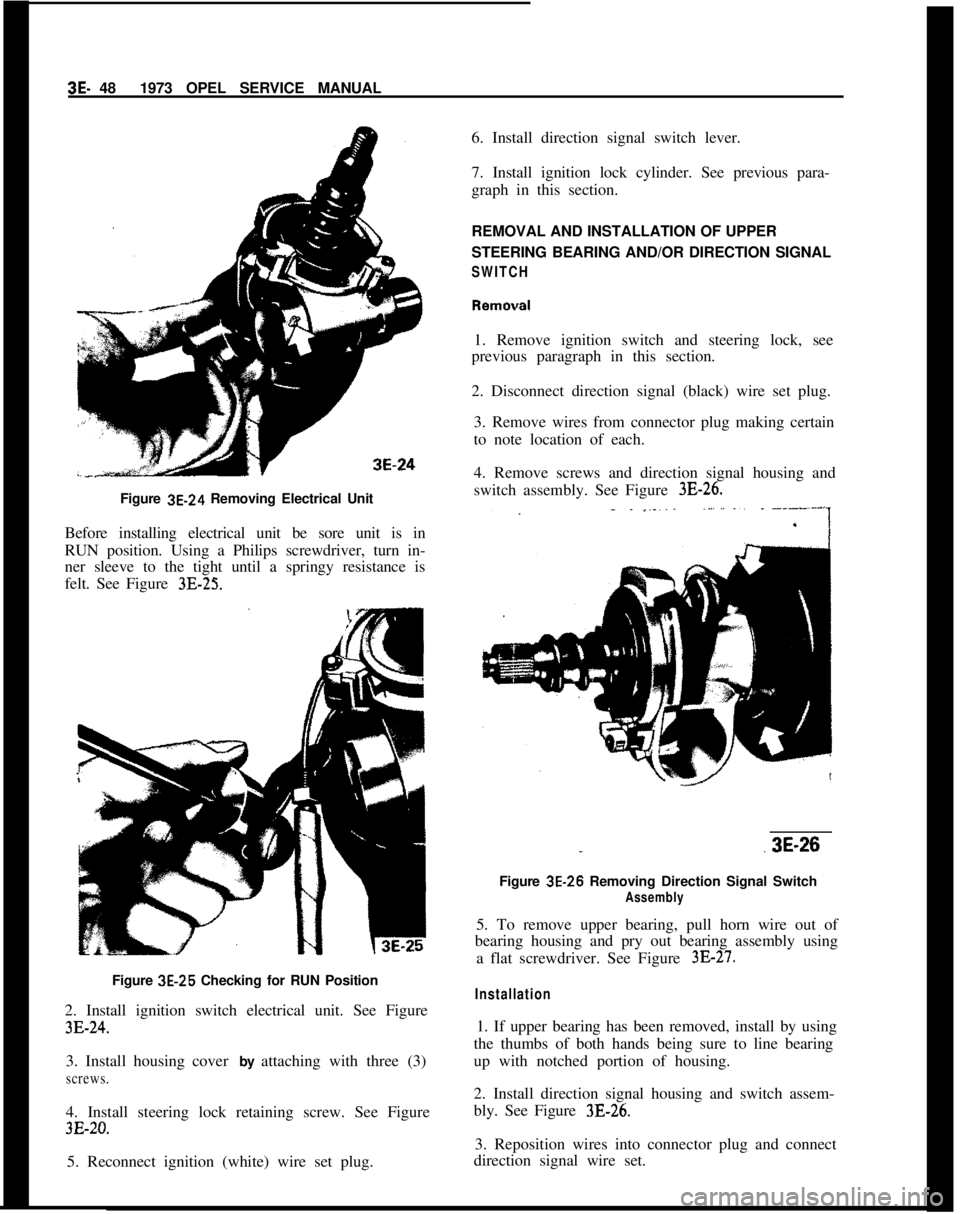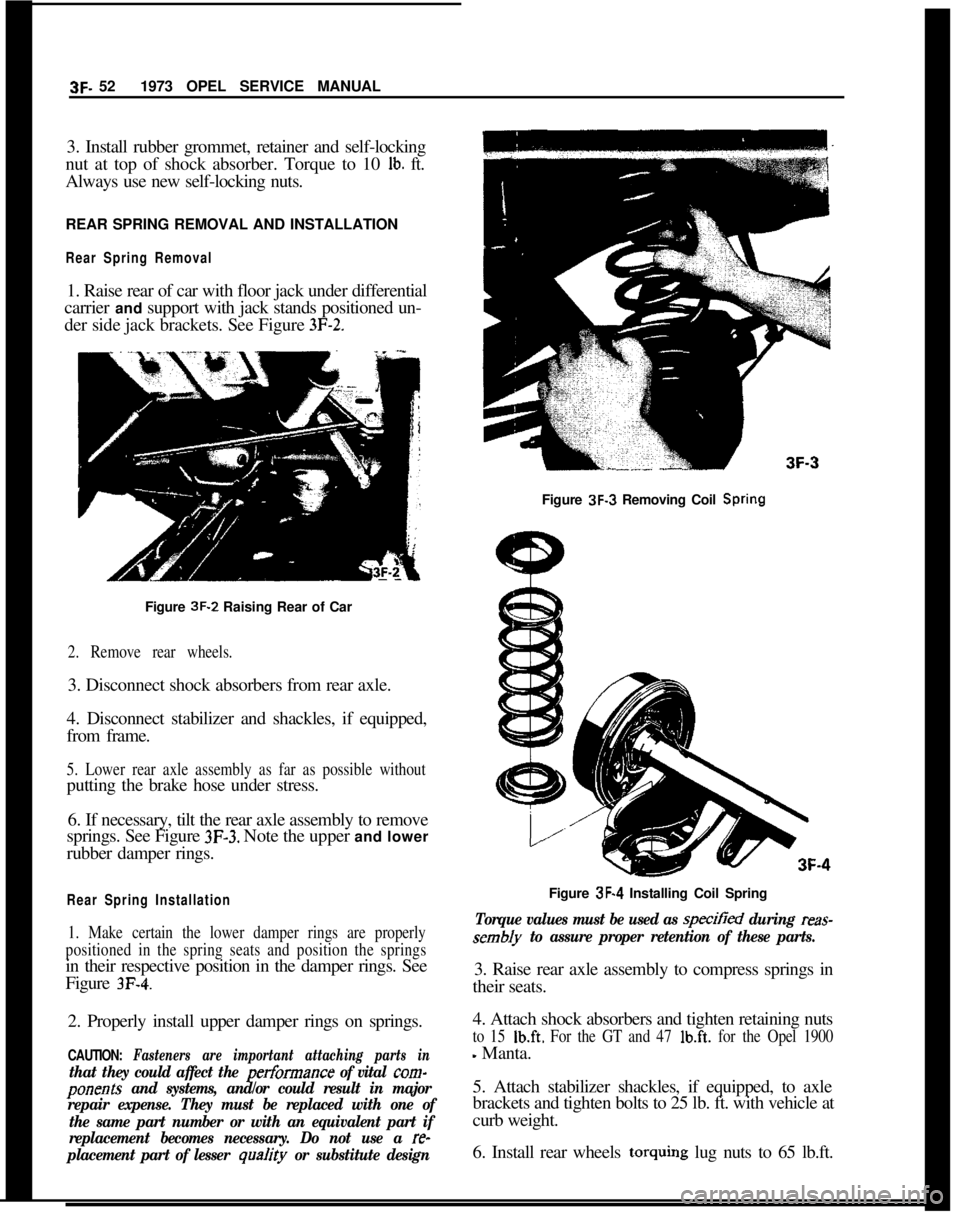OPEL GT-R 1973 Service Manual
Manufacturer: OPEL, Model Year: 1973, Model line: GT-R, Model: OPEL GT-R 1973Pages: 625, PDF Size: 17.22 MB
Page 211 of 625

3E. 441973 OPEL SERVICE’MANUAL
Figure 3E-17 Steering Column Bracket
installed in a car it is no more susceptible to damage
through usage than an ordinary column; however,
when the column is removed, special care must be
taken in handling this assembly.Only the speufied
wheel puller should be used.When the column is removed from the car, such
actions as a sharp blow on the end of the steering
shaft laying things across or on top of the column
assembly, leaning on the column assembly, or drop-
ping of the assembly could shear or loosen the plastic
fasteners that maintain column rigidity or possibly
bend the assembly causing a binding condition.
It is
therefore important that the removal and installation
and the disassembly and reassembly procedures be
strictly followed when servicing this assembly.The steering column assembly is attached with a
bracket (A) at four points to the connecting brace
below the instrument panel. See Figure
3E-17. The
two upper bolts are designed as tear-lock-bolts. A
bolt (B) is welded to the bracket which engages in an
narrowing elongated hole. The same applies to the
upper bolt (C) of the steering column lower bearing
attachment which engages in a hole of the connect-
ing brace.
As soon as a sufficiently large secondary energy
becomes effective, the steering mast jacket slides to-
wards the front whereby the bolt (B) as well as the
bolt head (C) is additionally pushed into the respec-
tive narrowing elongated holes. Both elongated holes
are arranged so that the primary energy cannot push
the steering mast assembly into the passenger com-
partment.
The GT steering column incorporates two universaljoints to allow
~for the offset between the steering
column and the gear assembly.
The upper steering column assembly is connected to
the center steering shaft with one universal joint,
while the lower universal joint connects the center
steering shaft to the steering gear pinion shaft.
REMOVAL AND INSTALLATION
REMOVAL AND INSTALLATION OF STEERING
WHEELThis procedure may be performed with the steering
column assembly either removed or installed in the
car.Removal
1. Disconnect battery.
2. Remove horn cap.
3. Bend lockplate tabs down and remove steering
wheel nut, lockplate and washer.
4. Mark shaft and wheel hub for reassembly align-
ment.
5. Remove steering wheel using steering wheel puller
J-21686. Do not rap on end of puller in order to free
wheel from shaft as this would very likely loosen
plastic injections that maintain steering shaft rigid-
ity. Striking of underside of steering wheel to jar it
Page 212 of 625

GT STEERING COLUMN ASSEMBLY3E- 45
loose must never be done. The only recommendation
for freeing frozen steering wheels is to use a penetrat-
ing lubricant.Installation1. Before installing steering wheel, lubricate return
pin and slide area on direction signal switch return
cams and horn ring contact.
2. With steering wheel properly aligned to shaft, in-
stall lockplate and nut. Torque nut to 15
Ib.ft.
CAUTION:
This steering wheel to steering shafi fas-
tener is an important attac&ng part in that it could
affect the performance of vital components and sys-
tems, and/or could result in major repair expense. It
must be
rep/aced with one of the same part number
or with an equivalent part, if replacement becomes
necessary. Do not use a replacement part of lesser
quality or substitute design. Torque values must be
used as specified during reassembly to assure proper
retention of this part.3. Bend up lockplate tab and install horn cap.
4. Reconnect battery.
REMOVAL AND INSTALLATION OF IGNITION
LOCK CYLINDER
RemovalThis procedure may be performed with the steering
column assembly either removed or installed in the
car.1. Remove steering wheel, as outlined previously in
this Group.
2. Position lock cylinder to run position.
3. Using suitable piece of wire, push in lock cylinder
retaining pin and remove lock cylinder. See Figure3E- 18.
Installation1. Insert lock cylinder into lock cylinder housing.
2. Install steering wheel, as outlined previously in
this section.
REMOVAL AND INSTALLATION OF STEERING
COLUMN ASSEMBLY
Removal1. Position steering so that front wheels are straight
ahead.Figure
3E-18 Removing Lock Cylinder
2. Loosen steering shaft upper universal joint lower
clamp bolt. See Figure
3E-19.3. Drill off heads of both tear bolts by first drilling
an 3/16 inch pilot hole and then inserting a
l/4 inch
bolt extractor to remove lockbolt.
4. Disconnect ignition (white) and direction signal
(black) wire set plugs.
5. Support steering column assembly and remove
both hex. head bolts.
6. Pull steering column assembly off center steering
shaft. Do not apply any force as plastic injections in
center steering shaft may be loosened and shaft
would then require replacement.
Installation
CAUTION:
Fasteners are important attachingparts in
that they
cooId affect the performance of vital com-
ponents and systems, and/or could result in major
repair expense. They must be replaced with one of
the same part number or with an equivalent part if
replacement becomes necessary. Do not use a re-
placement part of lesser quality or
substitute design.
Torque values must be used as specified during
reas-
sembIy to assure proper retention of these parts.1. Install steering column assembly onto steering
shaft and torque steering shaft upper universal joint
lower clamp bolt to 14
lb.ft.2. Install hex head bolts and torque to 14
lb.ft.
NOTE:
Be sure to install ground wire.
Page 213 of 625

I3E. 461973 OPEL SERVICE MANUAL
Figure 3E-19 Steering Column Attachments
3. Install new tear bolts and tighten until hex
head of bolt is tom off.
4. Reconnect ignition and direction signal wire sets.
REMOVAL AND INSTALLATION OF CENTER
STEERING SHAFT
RemovalSteering shaft must be handled carefully so as not to
loosen plastic injections as shaft would then require
replacement.
CAUTION:Fasteners are important attaching parts
in that they could affect the performance of vital
components and systems, and/or could result in
major repair expense. They must be replaced with
one of the same part number or with an
equivalent part if replacement becomes necessary.
Do not use a replacement part or lesser quality or
substitute design. Torque values must be used as
specitied during reassembIy to assure proper
retention of these parts.1. Install steering shaft through bottom and position
into upper universal joint.
1. Position steering so that front wheels are straight
ahead.2. Insert shaft into lower universal joint and torque
bolt to 22 lb.ft.
2. Loosen steering shaft upper universal joint lower
clamp bolt.3. Torque upper universal joint bolt to 14
lb.ft.3. Remove steering shaft lower universal joint upper
clamp screw.
4. Carefully push center steering shaft up into steel
washer joint until lower end is free.REMOVAL AND INSTALLATION OF IGNITION
SWITCH AND/OR STEERING LOCK
Removal5. Remove steering shaft through bottom.
1, Remove ignition lock cylinder, see previous para-
graph in this section.
Page 214 of 625

GT STEERING COLUMN ASSEMBLY3E- 47
2. Disconnect ignition (white) wire set plug.
3. Remove steering lock retaining screw. See Figure3E-20.Figure 3E-20 Steering Lock Retaining Screw
4. Remove direction signal switch lever.
5. Remove three screws securing signal switch cover
to housing.
6. To remove housing cover, (a) pull cover toward
direction signal switch and move it slightly to the
right. See Figure
3E-21. (b) Turn cover toward the
left and move it further to the right so that the left
retaining screw ear is positioned under the left signal
switch return cam. See Figure
3E-22. (c) Insert direc-
Figure 3E-2 1tion signal switch lever into oblong opening in cover
and push steering lock into housing and remove
cover. See Figure
3E-37.Figure
3E-22Figure 3E.23
7. Remove ignition switch electrical unit. See Figure3B24.
8. Remove wires from connector plug making certain
to note location of each.
9. Tape wire ends together and remove electrical unit
and wire harness.
Installation1. Position electrical unit wire harness through col-
umn and reconnect to connector plug.
Page 215 of 625

3E- 481973 OPEL SERVICE MANUAL
Figure 3E-24 Removing Electrical Unit
Before installing electrical unit be sore unit is in
RUN position. Using a Philips screwdriver, turn in-
ner sleeve to the tight until a springy resistance is
felt. See Figure 3E-25.Figure 3E-25 Checking for RUN Position
2. Install ignition switch electrical unit. See Figure
3E-24.3. Install housing cover by attaching with three (3)
screws.4. Install steering lock retaining screw. See Figure
3E-20.5. Reconnect ignition (white) wire set plug.6. Install direction signal switch lever.
7. Install ignition lock cylinder. See previous para-
graph in this section.
REMOVAL AND INSTALLATION OF UPPER
STEERING BEARING AND/OR DIRECTION SIGNAL
SWITCH1. Remove ignition switch and steering lock, see
previous paragraph in this section.
2. Disconnect direction signal (black) wire set plug.
3. Remove wires from connector plug making certain
to note location of each.
4. Remove screws and direction signal housing and
switch assembly. See Figure
3E-26.
..3E-26
Figure 3E-26 Removing Direction Signal Switch
Assembly5. To remove upper bearing, pull horn wire out of
bearing housing and pry out bearing assembly using
a flat screwdriver. See Figure
3E-27.
Installation1. If upper bearing has been removed, install by using
the thumbs of both hands being sure to line bearing
up with notched portion of housing.
2. Install direction signal housing and switch assem-
bly. See Figure 3B26.
3. Reposition wires into connector plug and connect
direction signal wire set.
Page 216 of 625

GT STEERING COLUMN ASSEMBLY3E- 49
4. Install ignition switch and steering lock
REMOVAL AND INSTALLATION OF STEERING
COLUMN LOWER BEARING
The following is with steering column assembly
removed.
1. Remove steering wheel.
2. Remove screws securing lower bearing housing to
mast jacket.
3. Remove steering shaft together with universal
joint and bearing and housing.
4. Remove universal joint from shaft. See Figure 3E-28.Figure 3627 Removing Upper Bearing
SERRATED SOCKET
“‘*E.Z<~lh I’
I//
11 uBEARING HOUSINGy
SE-28Figure 3E.28 Removing Lower Bearing
5. Remove bearing retainer snap ring and remove
bearing.
Installation3. Install steering shaft, together with universal joint
bearing and housing to mast jacket. Serrated socket
head screw must be installed on
tm side of steering
column assembly. See Figure 3E-2\.
1. Install bearing and bearing retainer snap ring.
2. Install universal joint and torque to 22
Ib.ft.4. Install steering wheel. On installation of steering
wheel, make sure that with flats of lower portion of
universal joint horizontal, the center steering wheel
spoke must be vertical.
Page 217 of 625

13E. 50 1973 OPEL SERVICE MANUALPART
Bolt
BoltLOCATION
Steering WheelUpper Universal Joint
- Lower Clamp
Upper Universal Joint
- Hex Head
Lower Universal Joint
TORQUE
LB.FT.
15
14
Page 218 of 625

REAR SUSPENSION3F- 51
REAR SUSPENSION
CONTENTS
Subject
DESCRIPTION AND OPERATION:
Description and Operation of Rear Suspension. . . . . .DIAGNOSIS: (Not Applicable)
MAINTENANCE AND ADJUSTMENTS: (Not
Applicable)
MAJOR REPAIR:
Rear Shock Absorber Removal and Replacement . .
Rear
SpringRemovalandInstallation. . . . . . . . . . . . . . . . . . . . . . . .LowerControlArmReplacement
. . . . . . . . . . . . . . . . . . . . . . . . . . . . . . . .Stabilizer
RodReplacement. . . . . . . . . . . ~ . . . . . . . . . . . . . . . . . . . . . ..-....Track Rod Replacement
. . . . . . . . . . . . . . . . . . . . . . . . . . . . . . . . . . . . . . . . . . . . . . . .SPECIFICATIONS:
Rear
SuspensionSpecifications. . . . . . . . . . . . . . . . . . . . . . . . . . . . . . . . . . . .Page No.3F-5
13F-513F-523F-533F-533F-533F-53
DESCRIPTION AND OPERATIONDESCRIPTION AND OPERATION OF REAR
SUSPENSIONAll Opels utilize the three link rear suspension ar-
rangement. This rear suspension consists of coil
springs, track rod, shock absorbers and lower control
arms.The coil springs set between two seats which arc
situated ahead of the rear axle housing.
The track rod is utilized on all models to control the
lateral stability of the rear axle assembly. It is of
tubular design. A stabilizer rod is used on all Wagons
as well as Fast Backs and Sedans. The GT is not
equipped with a stabilizer rod.
The lower control arms are of tubular design and
function as two links of the three link suspension
system. They are attached to the underbody through
brackets welded to the side rails and to the rear axle
assembly through the front portion of the spring seat
bracket. The lower control arms control the fore and
aft movement of the rear axle assembly.
The third link in this suspension system is the torque
tube which is connected to the differential carrier
and also to the underbody through rubber bushings
in the central joint support bracket.The torque tube in conjunction with the lower con-
trol arms absorb all acceleration and braking torque.
MAJOR REPAIR
REAR SHOCK ABSORBER REMOVALAND INSTALLATION
RemovalNOTE: The trim panel under the spare tire must be
removed on the GT to gain access to attaching nuts.
1. Remove upper attaching nut, retainer and rubber
grommet.
2. Remove lower attaching nut and rubber grommet
retainer, compress shock absorber and remove from
lower mounting pin.
Installation1. Replace upper and lower rubber grommets, if
necessary, before installing shock absorber.
2. Extend shock absorber and position in car. Attach
at lower end first, torque nut to 15 lb.ft. on the GT,
and torque to 47 lb.ft. on the Opel 1900
- Manta.
Page 219 of 625

3F. 521973 OPEL SERVICE MANUAL
3. Install rubber grommet, retainer and self-locking
nut at top of shock absorber. Torque to 10 lb. ft.
Always use new self-locking nuts.
REAR SPRING REMOVAL AND INSTALLATION
Rear Spring Removal1. Raise rear of car with floor jack under differential
carrier and support with jack stands positioned un-
der side jack brackets. See Figure
3F-2.Figure 3F-3 Removing Coil
SpringFigure 3F-2 Raising Rear of Car
2. Remove rear wheels.3. Disconnect shock absorbers from rear axle.
4. Disconnect stabilizer and shackles, if equipped,
from frame.
5. Lower rear axle assembly as far as possible withoutputting the brake hose under stress.
6. If necessary, tilt the rear axle assembly to remove
springs. See Figure
3F-3. Note the upper and lower
rubber damper rings.
Rear Spring Installation
1. Make certain the lower damper rings are properly
positioned in the spring seats and position the springsin their respective position in the damper rings. See
Figure
3F-4.2. Properly install upper damper rings on springs.
CAUTION: Fasteners are important attaching parts in
that they could affect the performance of vital corn-
ponents and systems, and/or could result in major
repair expense. They must be replaced with one of
the same part number or with an equivalent part if
replacement becomes necessary. Do not use a
re-
placement part of lesser
qua/ity or substitute designFigure 3F-4 Installing Coil Spring
Torque values must be used as specitied during reas-
sembly to assure proper retention of these parts.3. Raise rear axle assembly to compress springs in
their seats.
4. Attach shock absorbers and tighten retaining nuts
to 15 Ib.ft. For the GT and 47 lb.ft. for the Opel 1900
- Manta.
5. Attach stabilizer shackles, if equipped, to axle
brackets and tighten bolts to 25 lb. ft. with vehicle at
curb weight.
6. Install rear wheels torquing lug nuts to 65 lb.ft.
Page 220 of 625

REAR SUSPENSION3F- 53
7. Remove jack stands.
LOWER CONTROL ARM REPLACEMENTRemovalThis operation can be performed with the vehicle
standing at curb height or elevated.
1. Disconnect parking brake cable from support
bracket on control arm.
2. Loosen and remove front and rear control arm
attaching bolts and remove control arm.
installation1. On
1900’s and Manta’s place a load of approxi-
mately 350 lbs. in luggage compartment or on the
GT, place a load of approximately 150
Ibs. on dri-
ver’s seat. Torque control arm attaching nut and
bolts to 18 lb.ft on
GT’s and 23 Ib.ft. on the 1900 -Manta.
2. Connect parking brake cable to support bracket on
control
ranI.
STABILIZER ROD REPLACEMENT
Removal1. Raise and support rear of vehicle.
2. Disconnect stabilizer rod to shackle bolts.
3. Disconnect stabilizer rod to underbody retainers
and work stabilizer rod out from under vehicle.
SPECIFICATIONS
REAR SUSPENSION SPECIFICATIONS
Tightening SpecificationsInstallation1. Work stabilizer rod into position and loosely at-
tach stabilizer to underbody retainers.
2. Connect stabilizer rod to shackles.
3. With the vehicle standing on its wheels or the rear
axle assembly lifted, tighten stabilizer rod to under-
body bracket bolts to 15 lb. ft.
4. Remove jack stands and lower vehicle.
TRACK ROD REPLACEMENT
Removal1. Lift rear of car and suitably support.
2. Disconnect track rod from rear axle and frame
side member.
Installation
1. Loosely connect track rod first to side member and
then to the rear axle.
2. On the
1900 - Manta, load luggage compartment
of vehicle with approximately 350 lbs. or on the GT,
place a load of approximately 150 lbs. on driver’s
seat and tighten track rod attaching bolts to specified
torque.
3. Remove supports (jack stands) and lower vehicle.
Use a reliable torque wrench. Specifications are for clean and lightly-oiled
threads.
Part
Nut
Nut
Nut
Bolt
Nut
Nut
Nut
BoltName
WheelNuts.
.._.._......._........................................................
Control Arm Attaching (GT) .._.._.,,,........,,.,,.......,,......,,,,......
Control Arm Attaching (1 900 - Manta) .,,...._...,,,,_.....,,.,...
Stabilizer Rod to Underbody Retainers ,....._.,.,,.,.....,,,....
Shock Absorber Lower Attachment (GT) . .._.....,._.._.,,,...
Shock Absorber Lower Attachment (1900 Manta) ,,.,
Shock Absorber Upper Attachment. .._.....................
Stabilizer Shackle to Axle Bracket .._._.._,...._..,,.,,.......,,,...
Torque
Lb.Ft.
65
16
23
15
1,5
47
1025